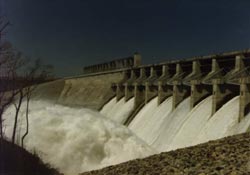
|
|
|
|
|
|
|
|
|
|
 |
|
|
| > APPLICATIONS | ||
| Baardheere Dam Project, Somalia | ||
|
The Somali Democratic Republic (Somalia), a country with a population
of about 7 million in northeast Africa has been the scene of some
of the worst droughts in recent history. Cycles of drought and
flooding are not uncommon. Because much of the output of the country
The Juba River in southwestern Somalia is the major river in the country. In 1977 a Somali government commission concluded that a reservoir on the Juba River would be technically and economically feasible. The site on the river that best satisfied engineering and cost considerations was 35 km north of the town of Baardheere. The proposed dam was designed for the purposes of flood control, irrigation, and hydroelectric power generation. In 1990 IMS Quantum (then Integrated Management Systems, Inc.) was engaged by the Earth Sciences and Resources Institute of the University of South Carolina to build an Integrated Decision Model as part of a larger study of the current feasibility of the Baardheere Dam Project. The Baardheere Dam was designed to produce 185 Megawatts at peak load while delivering 465 thousand cubic meters of water per second downstream. Since the peak requirement for irrigation was only 170 thousand cubic meters of water, some method was needed to maximize water usage efficiency. To accomplish this objective a schedule of pumping water back up into the reservoir was developed. Water that had been released during periods of high electric power demand and low downstream water demand was captured in a catchment basin below the dam. This water was pumped back up into the reservoir during periods of high water demand and low electric power demand. Thus periods of excess power were used to offset periods of excess water flow. The operations part of the model integrated the characteristics of water flow of the Juba River, electric power generation, electric power demand, water demand, and water pumping to show operational constraints and the interaction of the various objectives of the project. The cost/benefit analysis included the capital and operating costs of the dam, irrigation facilities, and pumping equipment as well as the value of electric power generated, the value of irrigation water used for sugar and rice production, and the value of ameliorating the cost of flood damage. The financing part of the model examined the sources of funds including revenues, averted government expenditures for flood damage, and loans from such sources as the World Bank and the International Monetary Fund. IMS Quantum specializes in the marriage of operational factors with financial considerations to create Integrated Decision Models that allow management to appreciate and optimize a variety of tradeoffs inherent in complex projects. |
||

 is agricultural, water is of primary importance, not only for the
survival of the largely rural population, but also for the maintenance
of dependable crop and livestock production for export.
is agricultural, water is of primary importance, not only for the
survival of the largely rural population, but also for the maintenance
of dependable crop and livestock production for export.